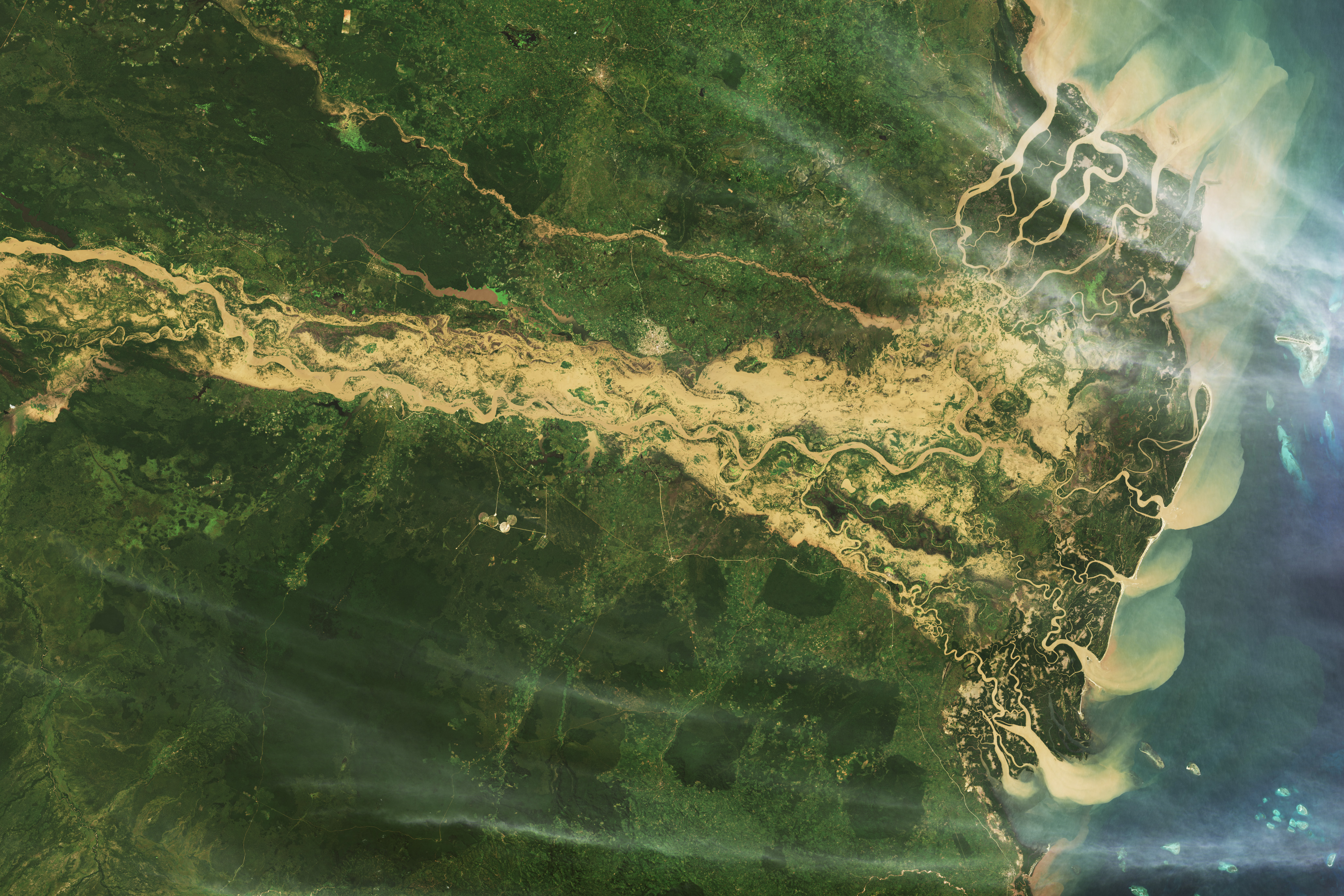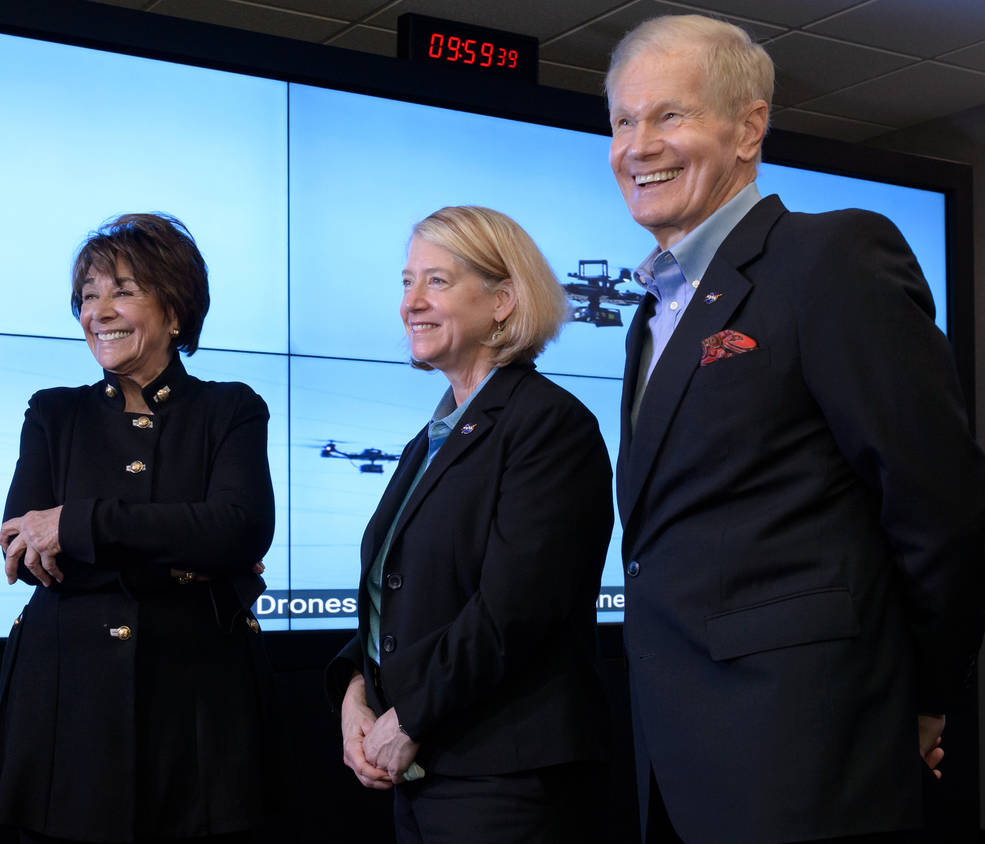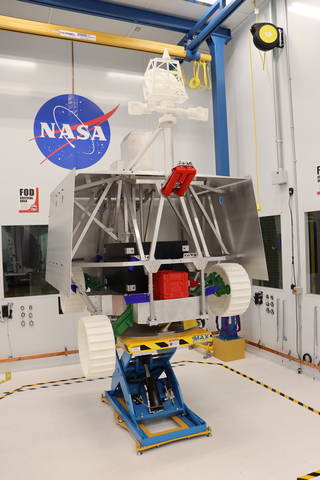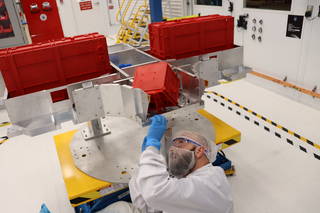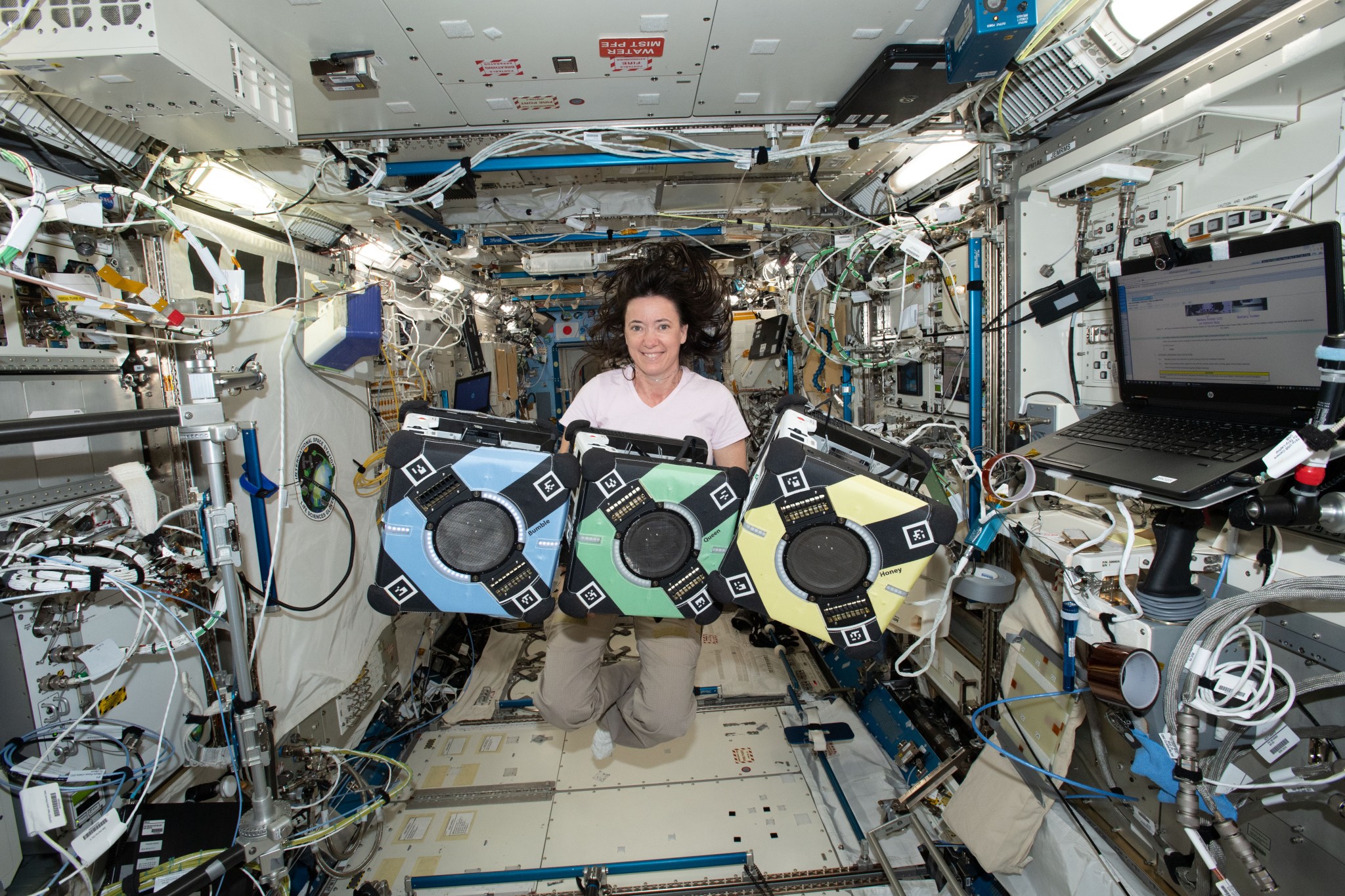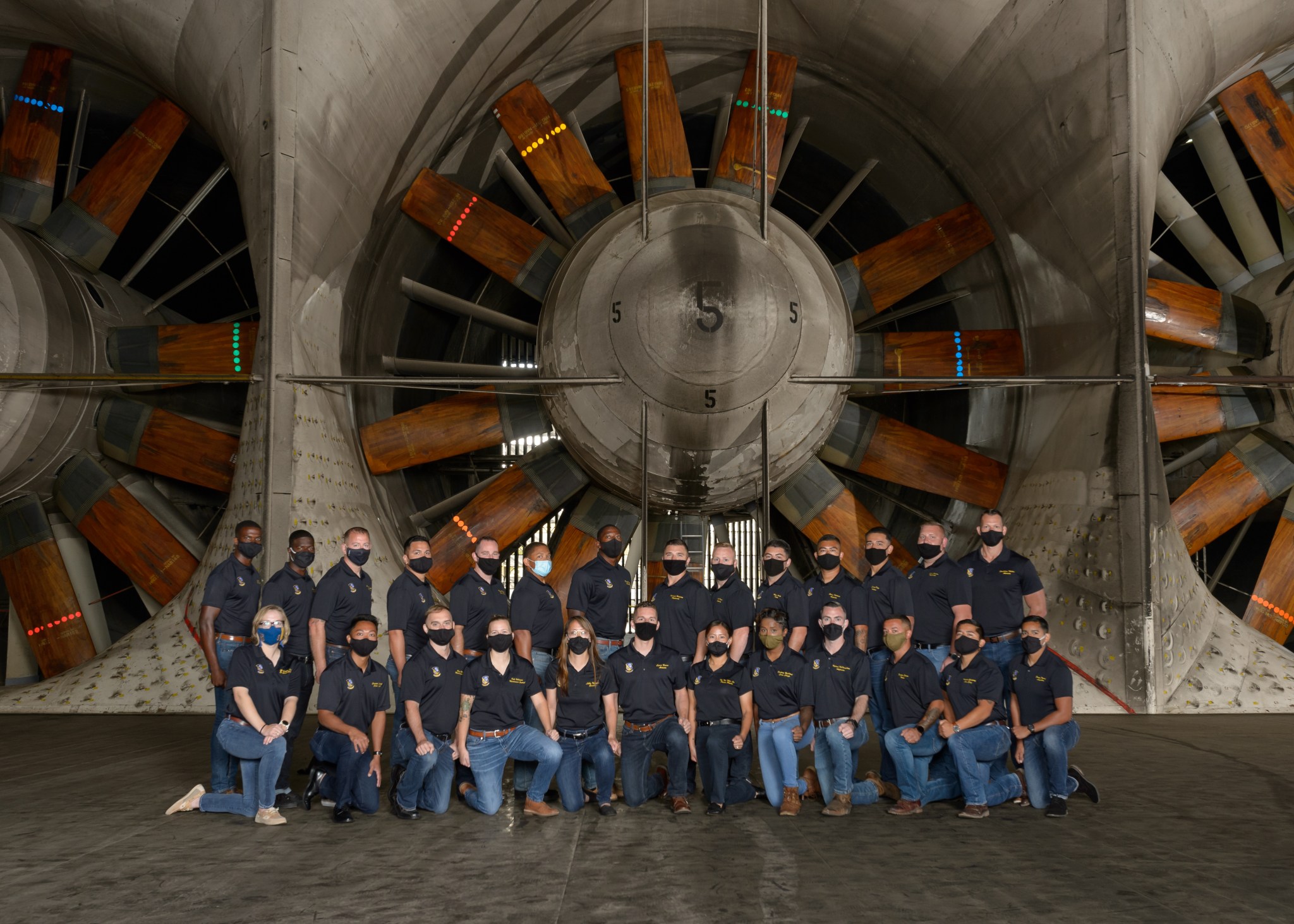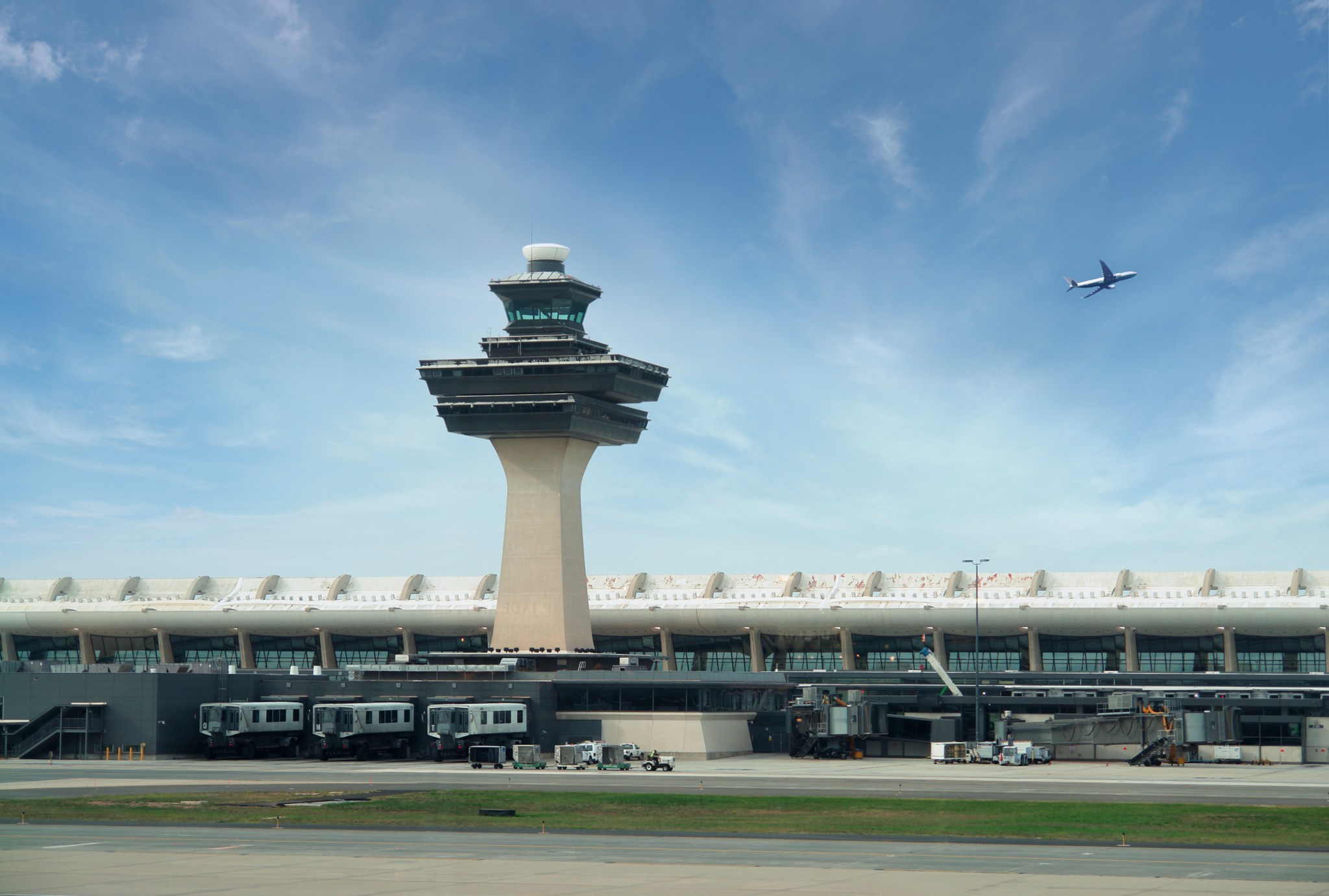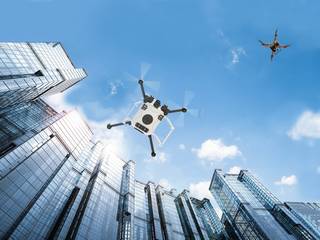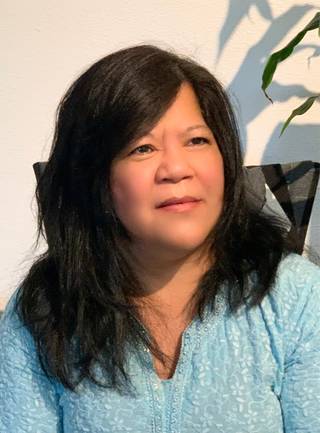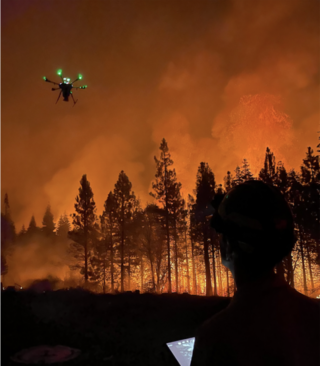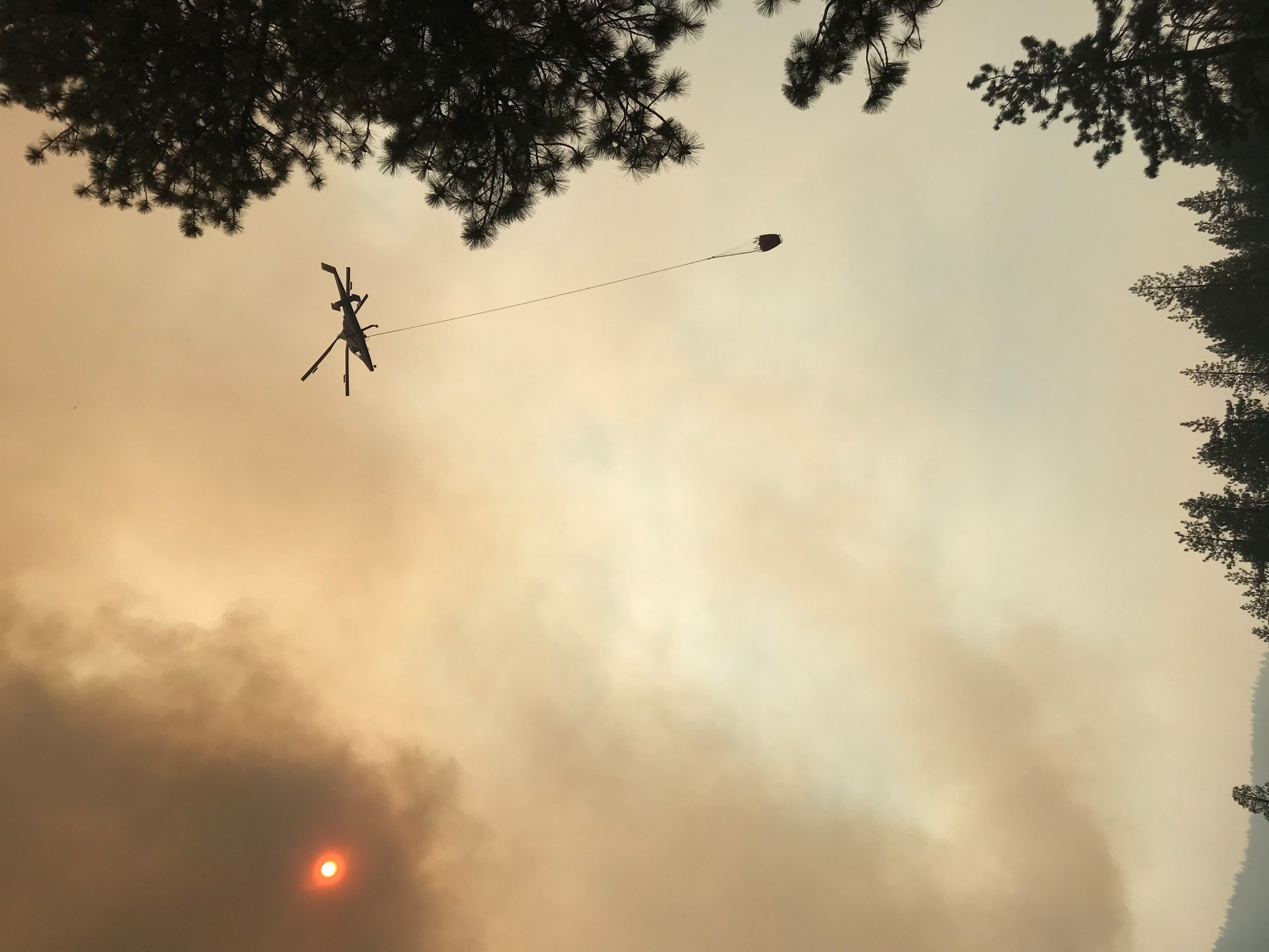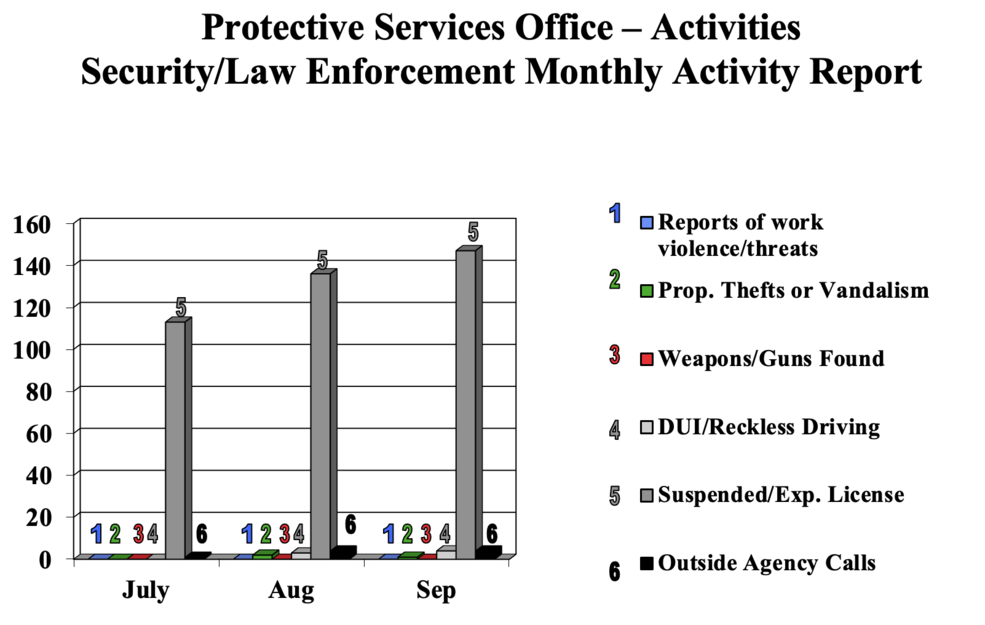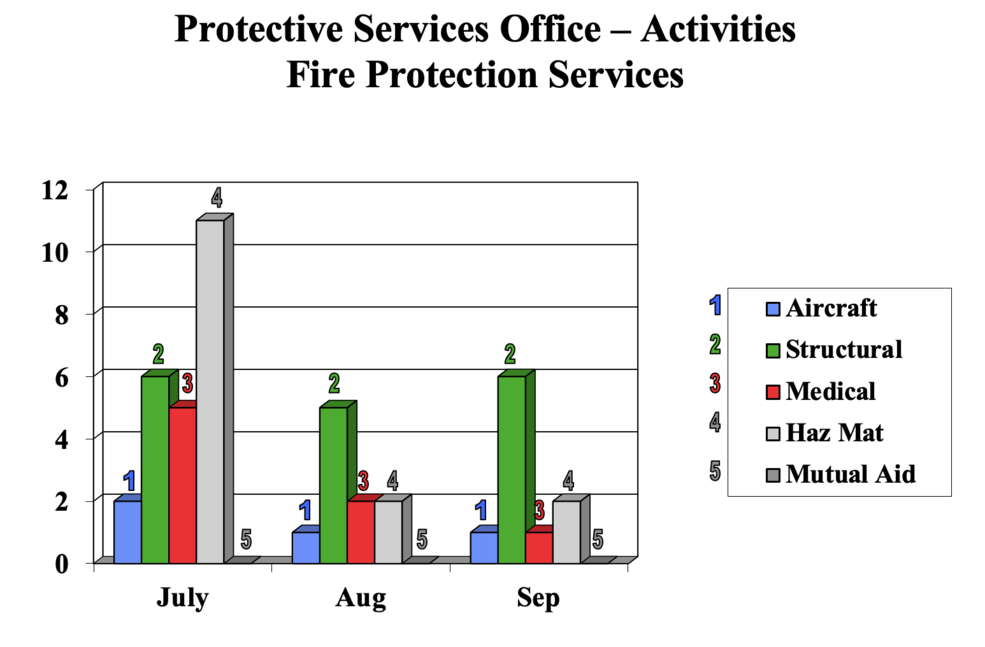October 2021 issue of the Ames newsletter, the Astrogram
At NASA Ames, Administrator Bill Nelson Sees Climate-related Tech and More
by Abigail Tabor
Both air and space technologies from NASA are helping to study and understand climate change – and the agency is actively taking steps to transition those tools into the hands of people who can make a difference.
This fact was highlighted by NASA’s leaders during a visit to the agency’s Ames Research Center in California’s Silicon Valley on Oct. 12, 2021. NASA Administrator Bill Nelson and NASA Deputy Administrator Pam Melroy toured the unique facilities at Ames for the first time, along with Congresswoman Anna Eshoo who also joined a portion of the tour.
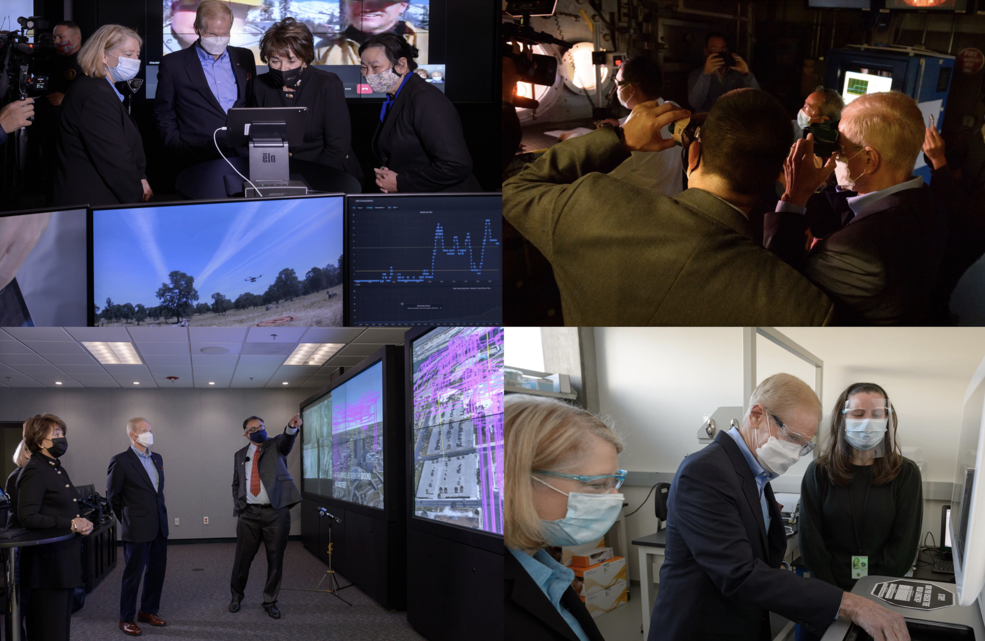
They met with researchers whose work transforming air traffic management is helping make aviation more sustainable. The Airspace Technology Demonstration 2, or ATD-2, project has already made it possible to reduce jet fuel emissions and save travelers time, among other concrete benefits.
Other new NASA technologies presented could enhance efforts to fight wildfires. The Scalable Traffic Management for Emergency Response Operations, or STEReO, project is creating a system for coordinating the many parts of a complex response operation, including uncrewed and piloted aircraft, to make it faster, safer, and more targeted.
On the tour, Nelson and Melroy also learned about Ames’ expertise in Earth sciences and, specifically, using sensors aboard aircraft and satellites to monitor the risk for wildfires, predict their course, and respond to their impacts.
The center’s contributions to the Artemis program were featured as well. At the arc jet facility, very hot gases move at high speeds over test materials to approximate the heating a spacecraft experiences when entering the atmosphere. When NASA sends humans to explore the Moon, the work of Ames researchers will help ensure the crew capsule’s heat shield protects them – and bring them home safely.
Space biology was also on the docket during the visit to Ames. Nelson and Melroy toured state-of-the-art laboratory spaces and met with team members of GeneLab, NASA’s open repository for space biology data from the human, animal, and plant biology experiments conducted on the International Space Station. Scientists and students can use this priceless data to study how living things are affected by spaceflight and speed up basic science discoveries that can help improve health in space and on Earth.
NASA’s Artemis Rover Passes Critical Design Review
by Katie Cousins
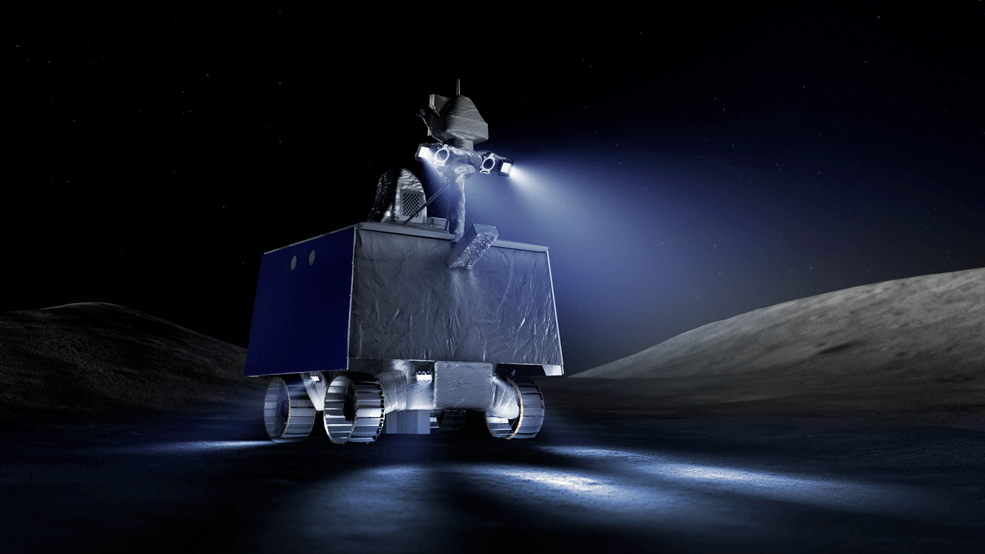
Lee este anuncio de prensa en español aquí.
NASA’s first lunar mobile robot, the Volatiles Investigating Polar Exploration Rover (VIPER) has passed its Critical Design Review (CDR), a critical milestone indicating that the rover has a completed design and has been approved by an independent NASA review board. The mission can now turn its attention to the construction of the rover itself, which will launch on a SpaceX Falcon-Heavy rocket for delivery to the Moon by Astrobotic’s Griffin lander under NASA’s Commercial Lunar Payload Services initiative.
As part of the Artemis program, the VIPER mission is managed out of NASA’s Ames Research Center in California’s Silicon Valley, and its primary objective is to get a close-up view of the location and concentration of ice as well as other resources at the Moon’s South Pole. By using an onboard suite of instruments developed across the agency and with commercial partners, the mission will be able to identify and eventually map where ice and other resources exist across and below the lunar surface. This resource mapping mission will bring NASA a significant step closer to its goal of the first long-term presence on the Moon and add to our understanding of the origin of lunar water.
“The VIPER team has been focused on completing the design of this clever little mission, bringing us to this culminating review,” said Daniel Andrews, VIPER project manager. “With an approved design, the team now looks toward turning that design into real hardware, bringing VIPER to life in 2022.”
Construction of the rover will begin in late 2022 at NASA’s Johnson Space Center in Houston, while the rover flight software and navigation system design will take place at Ames. Astrobotic will receive the complete rover with its scientific instruments in mid-2023 in preparation for launch later that year.
VIPER’s Design Passed its Final Test
The CDR is the final review that focuses on the system’s design. Ensuring that the rover’s systems and the instruments are able to work together is no easy task. Passing the mission’s CDR builds upon a series of previous Critical Design Assessments (CDA), where independent reviewers evaluated VIPER’s systems individually.
The earlier CDA’s focused on functions such as flight navigation systems and software, thermal and mechanical systems, and more. The CDR ensured these components are all capable of working together in a fully functional robotic system ready to explore the lunar surface.
Since VIPER passed its earlier milestone called the Preliminary Design Review, or PDR, the system design has evolved considerably, focusing on how to safely conduct maximum science on the lunar surface. The selection of the region west of Nobile Crater as the rover’s landing site was specifically chosen to be a good match for the capabilities of the overall VIPER system while also meeting all science goals.
A Design Ready to Reveal the Moon’s Secrets
This final, approved rover design weighs 992 pounds in total and can travel at a speed of 0.45 miles per hour. It uses a solar-charged battery with a peak power of 450 watts and features mounted headlights – the first NASA rover to do so. Using its cameras and headlights, VIPER will navigate around hazards and traverse into craters while staying connected to Earth using the Deep Space Network.
The rover and its components have been tested to endure the extreme lunar environment and answer key questions about the composition of the Moon. Using a hammer drill and three science instruments, VIPER will analyze drill cuttings for ice and other resources. VIPER will also study the soil and gasses in the lunar environment.
“Science will influence the VIPER mission in real-time unlike any mission that has come before this,” said Anthony Colaprete, VIPER lead project scientist. “It’s exciting to have the design approved and our collective ideas realized with this mission.”
Full-scale Artemis Rover Prototype Takes Shape
by Rachel Hoover
All the brightly colored plastic pieces might remind you more of something you’d find in a kids’ playroom than in a NASA clean room, but the team that built a full-scale replica of an early design of NASA’s Artemis water-hunting mobile Moon robot had some serious fun—while eliminating serious risk.
Using a mix of 3D-printed plastic and metal parts, the team walked through the meticulous and detailed process of assembling the science instruments and other critical rover components – like the wheels, lights, drill, and cameras – of NASA’s Volatiles Investigating Polar Exploration Rover, or VIPER. The rover is scheduled to be delivered near the western edge of the Nobile Crater at the Moon’s South Pole in late 2023 as part of the Commercial Lunar Payload Services initiative.
Piece by Piece
The golf-cart sized rover took shape during a recent practice build called the Surface Segment Assembly Pathfinder completed in the new clean room at NASA’s Johnson Space Center in Houston.
Composed of more than 100 parts and weighing in at 600 pounds, the pathfinder relied on a metal chassis and frame to give it strength and stability as engineers maneuvered it by crane or using a special lift-table. These tools provided engineers access to all the nooks and crannies in the belly of VIPER that they needed to reach to crank down fasteners, tighten bolts, and secure parts.
One unique feature of VIPER is its drill, which can reach depths up to three feet below the surface of the Moon in search of ice and other resources. Specialized training and equipment were required to elevate the rover so that the team could access and view the drill during the practice build.
“This pathfinder exercise allowed us the opportunity to make sure we have all the skills, tools, and accommodations in-place for VIPER’s flight-build, when keeping the pace will be especially critical,” said David Petri, VIPER’s system integration and test lead at Johnson. “Every detail counts, and this process helped reveal where the VIPER team could refine key design aspects to ensure a smooth build.”
It’s in the Details
The pathfinder build process revealed some tiny adjustments and improvements – like making sure the holes to connect separate parts align perfectly so bolts can slide through with zero resistance. The team encountered a few other challenges such as tool accessibility – and as a result made recommendations to slightly rotate instruments or move components so the actual flight-build will be easier.
“A good pathfinding exercise closely mimics the actual flight assembly and gives valuable experience as we capture each small step required to build the vehicle. This allows us to anticipate and work through potential roadblocks,” said Petri. “We’ve tested out our new facility and processes – and that’s important because even though building VIPER will be similar to things we’ve done for decades, every mission has elements that make it unique.”
Next up for the VIPER mission is its Critical Design Review in fall 2021, after which the actual flight parts and hardware manufacture will begin. Until then, Petri and his team are ready and waiting.
Oh, Hiiiiive! Astrobee Queen Wakes Up In Orbit
by Rachel Hoover
It’s lean, it’s green, and it’s a whole lotta Queen. It’s official – the International Space Station now has a Queen – Astrobee robot, that is.
On Sept. 20, 2021, NASA astronaut Shane Kimbrough unpacked, conducted health checks, and got cube-shaped Queen up-and-floating aboard the International Space Station. This was the first time Queen “woke up” in orbit after journeying to the space-based laboratory in 2019. How did it go? Absolutely perfect. Yass, queen!
Now that Queen is reunited with fellow free-flying robots Honey and Bumble, the trio can work alone or together to carry out investigations and experiments that will help develop technology – both hardware and software – for future missions. Next up – the ground-based team will begin planning activities for Queen, including testing its ability to tell where it is within the space station and ensuring it in full working order.
The Astrobee facility provides guest scientists a platform for zero-gravity robotics research inside the space station and is managed by NASA’s Ames.
Blue Angels Visit World’s Largest Wind Tunnels at NASA Ames
by Abigail Tabor
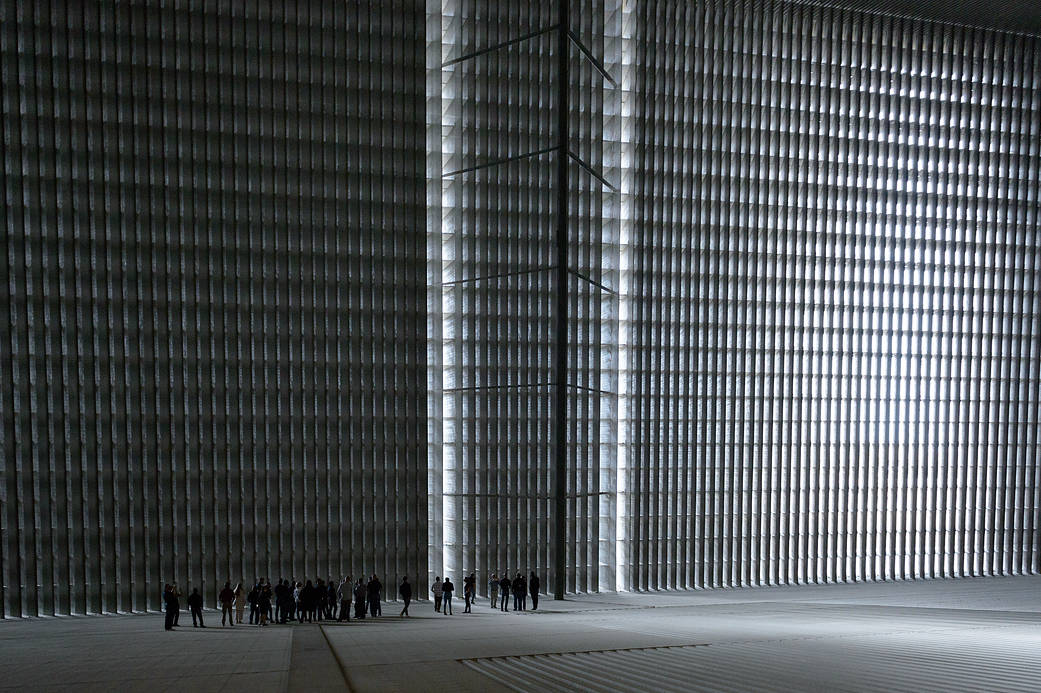
Members of the Blue Angels, the flight demonstration squadron of the U.S. Navy, visited NASA Ames on Oct. 6, 2021. During a tour here of the two biggest wind tunnels in the world, more than one Blue Angel could be heard expressing the possibility that the test engineers who work in these impressive facilities have the cooler job.
The National Full-Scale Aerodynamics Complex, or NFAC, includes two enormous wind tunnels with test sections measuring 40 by 80 feet and 80 by 120 feet. The facility at Ames is managed and operated by the U.S. Air Force. The NFAC provides vital testing for some of the nation’s most sophisticated commercial and military aircraft, spacecraft, wind turbines, trucks, and even the huge parachutes used to safely land NASA rovers on Mars. In this photo, the Blue Angels team members and NFAC staff are seen inside the football field-size air intake of the 80- by 120-foot wind tunnel.
The elite pilots who fly in Blue Angels air shows around the country are supported by a large team of specialists: mechanics, avionics technicians, crew chiefs, a flight surgeon… In town to perform a flight demonstration at San Francisco’s Fleet Week, the group couldn’t miss the chance to visit the local NASA center whose facilities make so many advances in aviation possible.
What is Air Traffic Management eXploration?
Transforming air traffic management to accommodate new air vehicles and demand for increased mobility
by Rachel Hoover
Operators of new and emerging aircraft – such as future Advanced Air Mobility vehicles or electric-powered vertical takeoff and landing vehicles – have big plans to fly in the U.S. airspace. But before that can happen, we’ll need to work with the Federal Aviation Administration, or FAA, to enable changes to the current airspace system while continuing to keep our skies safe. To make these new and growing aircraft operations a reality – while ensuring efficiency and safety – is where NASA’s Air Traffic Management eXploration, or ATM-X, project comes in.
ATM-X is developing innovative technology solutions that remove barriers to transforming today’s air transportation system and enabling new aircraft’s large-scale access, while also improving current aircraft operations. The end-goal is a digitally-integrated air transportation system that allows for increased mobility and safe, efficient access for both traditional and emerging operations and users – from commercial aircraft to delivery drones and urban air taxis.
By collaborating and partnering with a diverse group of industry participants, ATM-X will leverage their expertise to develop technology and define an airspace system that can scale up to handle the load of many and various aircraft. Industry continues to show strong interest by investing in, and contributing to, building airspace management systems. This includes their significant involvement with NASA’s Unmanned Aircraft Systems Traffic Management, or UTM. Systems based on the UTM paradigm can accelerate the transformation of the national airspace system in many ways. For example, they can play a role in expanding routine airspace access to more users, developing services to further the use of airspace information for air traffic controllers to service providers, and enabling more flexibility for a variety of piloted and pilotless aircraft to schedule and carryout their missions.
ATM-X leverages the convergence of airspace industry involvement with technological advances in cloud computing, faster computing speeds, communications systems capable of handling more data, and increasingly autonomous technologies. These key assets will unlock an airspace management system architecture that will transform the national airspace.
The ATM-X team works closely with the FAA to envision what the national airspace will be like in the year 2045. Experts anticipate a transformed airspace that will need to serve denser and more diverse flights, while maintaining or improving safety and efficiency. Advanced technologies, changes in market forces, and societal and environmental factors will all play a role influencing how the future system works. The team’s efforts will help guide future ATM-X research and development to identify technical barriers and research questions that need to be addressed.
ATM-X research and technology development has four subprojects, each focusing on different domains that contribute to transforming the national airspace, improving airspace access, and making operations more efficient for all users within the airspace system of tomorrow:
Digital Information Platform The Digital Information Platform subproject will develop and evaluate a prototype digital information platform software that takes data from many sources and turns it into easily accessible, easy-to-use digital information. This capability will provide necessary data for airspace management and users of the airspace system of the future.
Urban Air Mobility Airspace Management
The Urban Air Mobility Airspace Management subproject is developing increasingly sophisticated airspace management technologies that enable new electric aircraft to conduct passenger and cargo operations in urban areas as they fly at low altitudes, or less than 5,000 feet. The subproject will test airspace management technologies in support of NASA’s Advanced Air Mobility Project’s National Campaign. The team also will provide industry stakeholders with airspace system requirements and guidance toward a mature Urban Air Mobility airspace system.
Pathfinding for Airspace with Autonomous Vehicles Industry is developing increasingly autonomous aircraft that will revolutionize how we transport goods across the United States. The Pathfinding for Airspace with Autonomous Vehicles subproject will enable this new industry by improving the airspace system to provide routine access for these aircraft. This subproject will collaboratively develop airspace integration solutions to make remotely piloted commercial operations possible and increase levels of autonomous flight.
Extensible Traffic Management
The Extensible Traffic Management subproject is working with the FAA and industry to enable routine access of unmanned aircraft to our national airspace where aircraft fly above 60,000 feet. This work builds on thesuccess of NASA’s Unmanned Airspace Systems Traffic Management system for collaborative air traffic management. The team also is identifying additional use cases for a UTM-like extensible traffic management paradigm and how these operations would integrate with current air traffic.
Milestones:
- Completed final-stage development, testing, analysis, and knowledge transfer to the FAA of the Integrated Demand Management concept during ATM-X Phase 1 (June 2020)
- Completed ATM-X Phase 1, which explored challenging airspace use cases to identify and prioritize the key technical challenges to address in Phase 2, in order to achieve a transformed national air space (September 2020)
- Received approval to proceed with ATM-X Phase 2, which tackles these challenges (July 2020)
- Completed Urban Air Mobility subproject’s simulation activities, called “X3,” to assess the prototype airspace software under three flight scenarios (December 2020),
- Delivered prototype airspace software to the Advanced Air Mobility Project in support of the National Campaign Developmental Test (January 2021)
- The Extensible Traffic Management subproject signed a NASA-FAA Research Transition Team Joint Management Plan to collaborate on research and deliverables for airspace traffic management for aircraft flying above 60,000 feet through September 2025 (January 2021)
- The Digital Information Platform subproject released a Request for Information, receiving more than 40 responses, to facilitate partnerships to implement a prototype Digital Information Platform and services that utilize it. This will culminate in a series of collaborative demonstrations beginning in late 2022 (April 2021)
- The Pathfinding for Airspace with Autonomous Vehicles subproject will conduct its first simulation, focusing on separation assurance – or making sure aircraft maintain safe distances from other aircraft in the area. This is one of the key barriers identified toward achieving routine access for UAS into the airspace system (September 2021)
- The Urban Air Mobility Airspace Management subproject’s simulation activities, called “X4,” will advance the technology and test new information-sharing requirements – amongst service providers, and between providers and air traffic controllers – to enable safe, efficient urban air mobility operations while staying aware of increasing demands on the airspace. (August-September 2021). The subproject will deliver enhanced software to Advanced Air Mobility Project in support of the first full-scale National Campaign test in 2022.
Collaborators:
The ATM-X project includes team members from three NASA aeronautics centers, including Ames Research Center in California’s Silicon Valley; Glenn Research Center in Cleveland; and Langley Research Center in Hampton, Virginia.
ATM-X collaborates closely with sister-projects – System-Wide Safety and Airspace Technology Demonstrations – in the Airspace Operations and Safety Program, as well as Advanced Air Mobility in the Integrated Aviation Systems Program and Revolutionary Vertical Lift Technology in the Advanced Air Vehicles Program. All of these projects and programs fall under the leadership of NASA’s Aeronautics Research Mission Directorate in Washington.
ATM-X partners with the FAA to develop new technologies for adoption into their future infrastructure. It also partners with industry stakeholders to collaborate on concept and technology development the community is most likely to leverage.
Learn more:
- NASA feature: NASA Sets Stage for Future Flights, Auditions Advanced Air Mobility Technologies (Jan. 26, 2021)
- NASA feature: Challenge is On to Design Sky for All (Dec. 17, 2015)
- NASA feature: What is Unmanned Aircraft Systems Traffic Management? (May 27, 2021)
Tra-My Justine Richardson, from Refugee to Award Winning Scientist
by Maria C. Lopez
Tra-My Justine Richardson, a research physical scientist at NASA Ames, will receive a Technical Research Achievement Award from the Society of Asian Scientists and Engineers (SASE) at the 2021 SASE National Convention. This award is presented to a person who has achieved substantial technological advancement in a research field.
Richardson was born in Dalat, Vietnam. During the last days when communist occupation was eminent, her parents looked for escape routes. Since her mother worked on the U.S. military base in Saigon and her father was a civil engineer, they likely faced death or concentration camps under the new regime. Richardson was instructed to not discuss the escape plans with anyone. Those planning to escape were jailed and neighbors were known to report each other. To avoid suspicions from neighbors, she continued to go to school. At school, the class started the day by singing a song for all the children who died the day before in school bombings. She remembers thinking, “Will someone sing a song for us tomorrow?”
Since her family was at risk, they were allowed to board one of the last U.S. military cargo planes out of Vietnam from Tan Son Nhat International Airport on April 30, 1975, the day the war was lost. At a refugee camp in Guam, she stood in long lines for hours for a piece of bread, butter, and an apple – which was the breakfast menu. If she finished eating early, she would run to the other side of the camp and line up for another piece of bread and another apple. Months later, Richardson’s family boarded a plane to a refugee camp in Philadelphia. Eventually, under the Catholic church sponsorship, the family moved to Austin, Texas, in 1975. In 1976, her family moved to California to be near her grandfather and a year later her father died of colon cancer at the age of 37.
Richardson’s mother worked tirelessly to provide for her nine young children. With no adult in the house, she learned life skills and discovered the world through reading books. While attending grade school and barely grasping the English language, books opened her world and she learned how to swim, play tennis, get help with homework, plant flowers, organize her house, cook dinner for her family, and apply for colleges. She was fascinated with science because in science, there is order in chaos: explore, theorize, collect evidence, and make conclusions. In real life, nothing is certain.
Her dad had been a successful civil engineer in Vietnam. Yet, through no fault of his own, he washed dishes for a living when the family arrived in the U.S. because he did not speak English well and did not have a degree from a U.S. college. Lacking parental guidance and adult mentors and with a slight grasp of the English language, Richardson stumbled through life and eventually earned a bachelor of science degree in chemical engineering. For her senior project, her team designed a new nitrogen oxide removal system for the NASA Ames arc jet facility.
After graduation, she continued with the Bioengineering Branch at Ames to develop various forward osmosis (FO) membrane processes to recycle spacecraft wastewater into potable water: the Direct Osmosis Concentration (DOC) system, the Offshore Membrane Enclosures for Growing Algae (OMEGA), and the Forward Osmosis Secondary Treatment (FOST). In 2012, along with three of her coworkers, she was awarded the “Water Wall for Life Support” patent.
In 2013, she joined the Air Revitalization group at Ames for which she helped develop membrane and adsorbent systems to remove water and carbon dioxide (CO2) from International Space Station (ISS) cabin air. Her group worked closely with the Marshall Space Flight Center to select zeolites for the 4BCO2 (launched in June 2021). She also developed the CO2 and water removal (COHO) system and the Multifunctional Sorbent Device (MultiSORB) project. The COHO system used the waste (CO2) to drive the clean water (from the wastewater) across the FO membrane. The COHO project resulted in collaboration with the University of Puerto Rico Established Program to Stimulate Competitive Research (EPSCoR) for developing novel membranes and amines. Collaborating with the thermal protection branch at Ames, the MultiSORB project aims to embed heaters and sensors in a zeolite matrix for use in removing contaminants from cabin air.
In 2019, Richardson joined the solid waste group at Ames to develop systems to manage solid waste in spacecrafts: the Trash Compactor Processing System (TCPS), fecal processing, and the jettisoning of trash from spacecraft. On average, humans can survive three minutes without air, three days without water, and three weeks before solid waste contaminants become a problem. As such, when the ISS was first launched, the regenerative Air Regeneration System was installed. In 2010, the Water Processing Assembly (WPA) was installed to recycle urine and humidity condensate into potable water. The TCPS is scheduled for a flight demonstration aboard the ISS in 2024.
Throughout her life, the biggest obstacles she faced were learning how to overcome issues related to being a first-generation refugee, the loss of her father at an early age, and nightmares related to post-traumatic stress disorder (PTSD) resulting from the war. Much time has passed since her childhood and she doesn’t remember the melody or the lines to the song that she sang for the children who died in the bombings. When she thinks about those children, she realizes that those kids live through her. The memories of these children give her purpose, strength, determination, and focus. Her accomplishments are but a small contribution to what those children could have done had they made it out of school alive.
Last year, Richardson was inspired by Melinda Gates’ book “The Moment of Lift.” Gates spoke about how women from all over the world, and from all walks of life, can be “lifted up.” Richardson thought about how she could have benefited from being lifted as a little girl in Vietnam and as a refugee here in the United States. The Vietnamese culture believes that one should live for other people. She discovered that by lifting herself, she is better able to lift others. Today, she is married, a mother to a 12-year-old boy, and working on her Ph.D. in environmental engineering. Currently, she is working on life-support systems for space missions beyond low-Earth orbit.
As a NASA scientist, Richardson strives to give back to the United States, to let the public know all the wonderful things NASA is doing, and to inspire others to walk toward their dreams. She rose from a little refugee girl who dodged bombs to someone who is proud that the U.S. public has entrusted her to be a part of carrying out the nation’s vision for space exploration.
At California Blazes, NASA Team Observes How Drones Fight Wildfire
by Abigail Tabor
Armed with fire-retardant clothing, a helmet, headlamp, and flashlight, NASA’s Joey Mercer spent a night in August scrambling over rocks. He was in the woods of Northern California shadowing a team fighting the Dixie fire – the second-largest wildfire in the state’s history to date. In September, he and teammates made their way to three more California wildfire events, watching and learning as firefighters on the ground used small uncrewed aircraft to help battle blazes from above.
Mercer is the principal investigator for the Scalable Traffic Management for Emergency Response Operations, or STEReO, project at NASA Ames. His team is designing software and communication tools to help disaster responders work more safely and efficiently. Part of their approach is to scale up the use of unmanned aircraft systems, or UAS, also called drones.
Drones are good for capturing thermal images of the landscape below, for example. The heat signatures obtained can help determine where firefighters should establish fire-containment lines, dug either by bulldozer or by hand. Mercer was in the forest that night to observe firefighting UAS operators in action.
“The smarter we are about their operations, the smarter capabilities we can create,” said Mercer. “They’re running operations at night. They don’t know what terrain they’ll encounter, or where they can launch their aircraft from. There are so many details about their working environment that are hard to capture in conversation or get lost in translation.”
On the Ground at California Wildfires
To help make their tools as useful as possible, Mercer and members of his team joined wildland firefighters in the very real-world setting of active wildfires.
Between the Dixie, Caldor, McCash, and Windy fires, scattered across the state, but concentrated in Northern California, they shadowed drone pilots and incident commanders from three different agencies. They gleaned important, behind-the-scenes information from members of the California Department of Forestry and Fire Protection, or CAL FIRE, the U.S. Forest Service, and the National Park Service.
On the frontlines of the Dixie fire, a drone was sent to look for any traces of fire down a steep gully. The thermal data it collected helped decide whether crews could safely attempt to hold the fire there, or if they should work from the next ridgeline, even if it meant losing more acres to the flames.
Decisions like these were occurring all over the wildfire zone, under rapidly changing conditions.
“It really speaks to how critical information is in their decision making,” said Mercer, “and the timing of when that information becomes available to the various decision makers has a huge impact on the overall operation.”
The location of nearby piloted aircraft is one example of essential information the STEReO team is working to provide to drone pilots. The challenge of tracking those aircraft is the focus of STEReO’s prototype tool kit for drone pilots.
At the McCash fire, the team deployed the pilot kit for the first time during an active incident. This was an important opportunity, both for the team to test their technology in a true operational setting, and for the firefighters to see it at work. That context easily and efficiently revealed how the tools could be improved in the next round with certain tweaks.
Mercer also experienced firsthand why their tools must be entirely portable, as he and his group pushed past stubborn tree branches to approach the edge of a canyon, searching for a spot to launch their drone. The STEReO team has been testing its portable internet that can provide local connectivity, even in remote settings. His experience at the fires showed how it needs to be packaged so even a firefighter hiking into the middle of nowhere can carry it.
Witnessing how much the drone pilots were juggling was informative for the NASA team. They observed pilots having to make fast decisions by following fire-tactics updates via radio, while also tracking their drones in flight. This told the designers of STEReO’s software capabilities – like those for tracking piloted aircraft above and teams on the ground – that audio notifications could be an important feature to add. UAS operators may not have the luxury of monitoring their airspace on a screen.
Drone pilots remain fairly rare at wildfire response operations, while the fire community works with partners like STEReO to find the safest, most efficient ways to take advantage of their unique contributions. As California’s fire season burns on, the NASA team will continue its observations in the field, learning from the firefighting experts how STEReO’s tools could help them most.
STEReO is led by Ames in collaboration with two other NASA centers: Langley Research Center in Hampton, Virginia, and Glenn Research Center in Cleveland, Ohio. STEReO’s partners range from federal agencies to city and state fire departments, utilities, and private companies. The work is a concept study under NASA’s Convergent Aeronautics Solutions initiative. The results of the CAS study, designed to determine STEReO’s feasibility, will be used to determine whether and how NASA will pursue further development.














